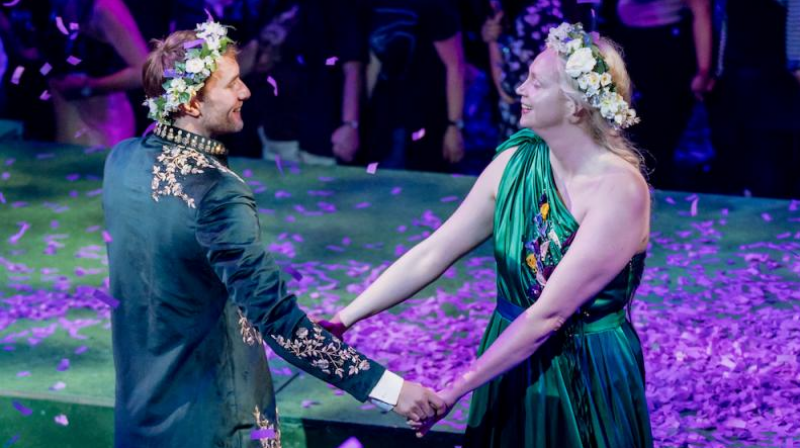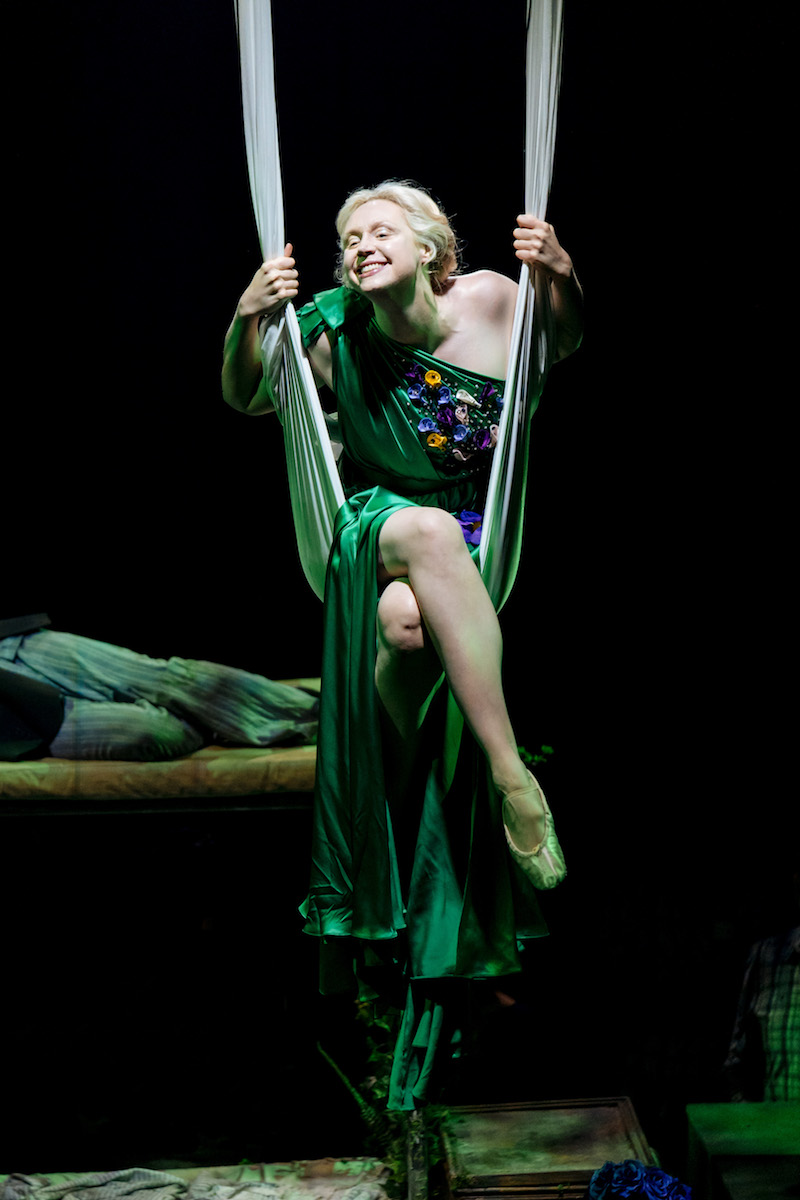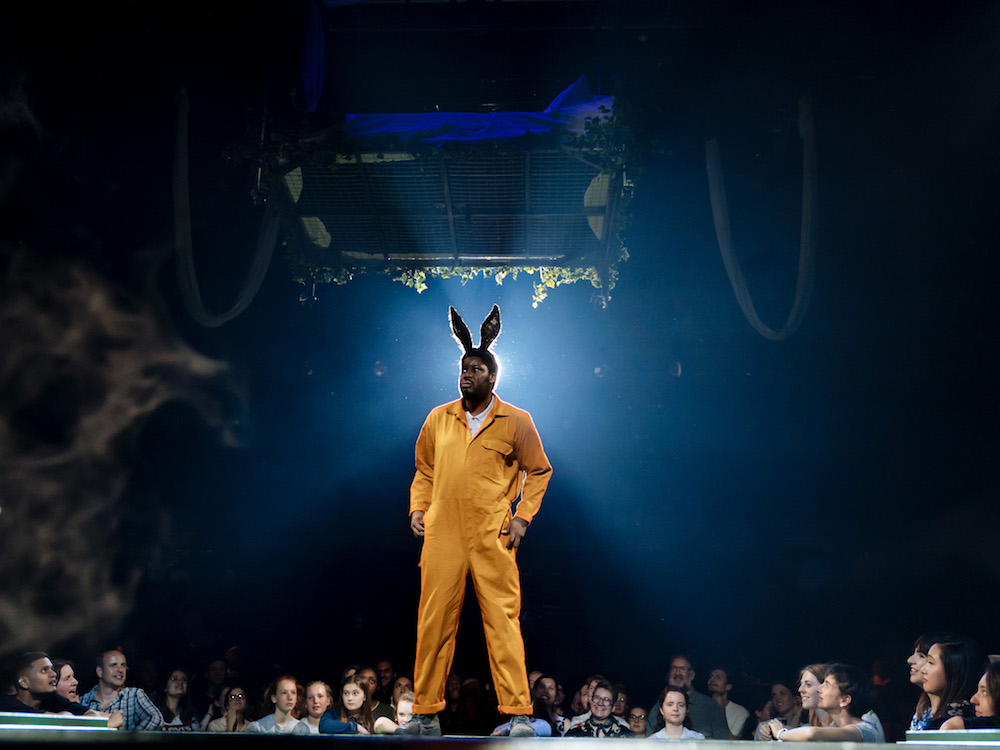A Midsummer Night's Dream, National Theatre At Home review – a mad delight | reviews, news & interviews
A Midsummer Night's Dream, National Theatre At Home review – a mad delight
A Midsummer Night's Dream, National Theatre At Home review – a mad delight
Nicholas Hytner makes the familiar gloriously strange in this slippery, sumptuous show

Nicholas Hytner’s A Midsummer Night’s Dream, filmed for NT Live at the Bridge Theatre last summer, is – as it gleefully acknowledges – completely bonkers. But it doesn’t start out that way.
 It’s a testament to Hytner’s skill that he’s able to balance dream and reality so well. His trick is to switch up Titania (Gwendoline Christie, pictured right) and Oberon’s (Oliver Chris) lines: here, it’s the fairy king who falls in love with an ass-headed mortal, the queen who manipulates him via Puck (a genuinely otherworldly David Moorst). But Oberon and Bottom’s (Hammed Animashaun) relationship isn’t the butt of the joke. Everything is imbued with such warmth and fondness that it’s like the show is laughing with the audience every step of the way. NT Live can’t recreate the experience of being in the crowd, but you can still feel the sheer delight of this production. “Plays are boring!” Puck whines when he comes across the Rude Mechanicals. Not this one, Robin.
It’s a testament to Hytner’s skill that he’s able to balance dream and reality so well. His trick is to switch up Titania (Gwendoline Christie, pictured right) and Oberon’s (Oliver Chris) lines: here, it’s the fairy king who falls in love with an ass-headed mortal, the queen who manipulates him via Puck (a genuinely otherworldly David Moorst). But Oberon and Bottom’s (Hammed Animashaun) relationship isn’t the butt of the joke. Everything is imbued with such warmth and fondness that it’s like the show is laughing with the audience every step of the way. NT Live can’t recreate the experience of being in the crowd, but you can still feel the sheer delight of this production. “Plays are boring!” Puck whines when he comes across the Rude Mechanicals. Not this one, Robin.
The versatility of Bunny Christie’s set suits the play’s shifting ground perfectly. Characters disappear into the audience and pop up in unexpected places. The audience disappears and pops up in unexpected places – kudos to the stage crew for what’s essentially an extended exercise in crowd control. This is a play that reminds us of the word’s roots: a light-footed, dancing thing, as graceful as the fairies spinning on their aerial silks (inspired by Peter Brook’s 1970 production for the RSC). Moorst had only had three months’ training before rehearsals started, but just watching him swoop and tumble is enough to make your feet cramp.
Animashaun (pictured below), along with Kit Young (a superbly angsty Lysander) and Isis Hainsworth (an all-guns-blazing Hermia), was nominated for the Ian Charleson Award for his performance, with good reason: it’s like Bottom was written for him. He’s witty, coy, sweet, and vulnerable, sometimes all in a matter of seconds. He can do things with his eyes that most actors can’t do with their whole bodies. And he makes full use of Hytner’s penchant for weaving extra lines seamlessly into the text, bringing Shakespeare just that little bit closer to today. As does the Titania-Oberon switch, of course. Sexualities and gender presentations are slipped on and off as smoothly as Oberon’s gorgeous golden robe (costumes by Christina Cunningham), all to a sumptuous soundtrack of Beyoncé and Florence and the Machine.

The play escapes a tragic ending by the skin of its teeth, thanks to Titania/Hippolyta. As with all good adaptations, it’s difficult to see how it could have been any other way. Of course it makes more sense for Titania to run fairy rings around Oberon, and for her gentle reminder of his affair with Bottom to nudge him into a more lenient attitude towards the lovers. Who would deny the magnificent Christie all the power she wants? Even shut up in a glass box like she’s on Naked Attraction, she’s more prowling tiger than caged bird. She and Chris are brilliant together, all the more so when he’s struck by a beautifully-timed attack of the giggles. That it doesn’t kill the mood illustrates perfectly the calibre of spell the show has cast.
A Midsummer Night’s Dream has a vaguely apocalyptic air about it – there’s a sense that a danger more threatening than the fairies’ harmless mischief is lurking just underneath the surface. But this show is still the perfect escape back into a world where people moved through thronged crowds and clasped strangers’ hands unthinkingly.
The future of Arts Journalism
You can stop theartsdesk.com closing!
We urgently need financing to survive. Our fundraising drive has thus far raised £49,000 but we need to reach £100,000 or we will be forced to close. Please contribute here: https://gofund.me/c3f6033d
And if you can forward this information to anyone who might assist, we’d be grateful.

Subscribe to theartsdesk.com
Thank you for continuing to read our work on theartsdesk.com. For unlimited access to every article in its entirety, including our archive of more than 15,000 pieces, we're asking for £5 per month or £40 per year. We feel it's a very good deal, and hope you do too.
To take a subscription now simply click here.
And if you're looking for that extra gift for a friend or family member, why not treat them to a theartsdesk.com gift subscription?
more Theatre
 Mary Page Marlowe, Old Vic review - a starry portrait of a splintered life
Tracy Letts's Off Broadway play makes a shimmeringly powerful London debut
Mary Page Marlowe, Old Vic review - a starry portrait of a splintered life
Tracy Letts's Off Broadway play makes a shimmeringly powerful London debut
 Little Brother, Soho Theatre review - light, bright but emotionally true
This Verity Bargate Award-winning dramedy is entertaining as well as thought provoking
Little Brother, Soho Theatre review - light, bright but emotionally true
This Verity Bargate Award-winning dramedy is entertaining as well as thought provoking
 The Unbelievers, Royal Court Theatre - grimly compelling, powerfully performed
Nick Payne's new play is amongst his best
The Unbelievers, Royal Court Theatre - grimly compelling, powerfully performed
Nick Payne's new play is amongst his best
 The Maids, Donmar Warehouse review - vibrant cast lost in a spectacular-looking fever dream
Kip Williams revises Genet, with little gained in the update except eye-popping visuals
The Maids, Donmar Warehouse review - vibrant cast lost in a spectacular-looking fever dream
Kip Williams revises Genet, with little gained in the update except eye-popping visuals
 Ragdoll, Jermyn Street Theatre review - compelling and emotionally truthful
Katherine Moar returns with a Patty Hearst-inspired follow up to her debut hit 'Farm Hall'
Ragdoll, Jermyn Street Theatre review - compelling and emotionally truthful
Katherine Moar returns with a Patty Hearst-inspired follow up to her debut hit 'Farm Hall'
 Troilus and Cressida, Globe Theatre review - a 'problem play' with added problems
Raucous and carnivalesque, but also ugly and incomprehensible
Troilus and Cressida, Globe Theatre review - a 'problem play' with added problems
Raucous and carnivalesque, but also ugly and incomprehensible
 Clarkston, Trafalgar Theatre review - two lads on a road to nowhere
Netflix star, Joe Locke, is the selling point of a production that needs one
Clarkston, Trafalgar Theatre review - two lads on a road to nowhere
Netflix star, Joe Locke, is the selling point of a production that needs one
 Ghost Stories, Peacock Theatre review - spirited staging but short on scares
Impressive spectacle saves an ageing show in an unsuitable venue
Ghost Stories, Peacock Theatre review - spirited staging but short on scares
Impressive spectacle saves an ageing show in an unsuitable venue
 Hamlet, National Theatre review - turning tragedy to comedy is no joke
Hiran Abeyeskera’s childlike prince falls flat in a mixed production
Hamlet, National Theatre review - turning tragedy to comedy is no joke
Hiran Abeyeskera’s childlike prince falls flat in a mixed production
 Rohtko, Barbican review - postmodern meditation on fake and authentic art is less than the sum of its parts
Łukasz Twarkowski's production dazzles without illuminating
Rohtko, Barbican review - postmodern meditation on fake and authentic art is less than the sum of its parts
Łukasz Twarkowski's production dazzles without illuminating
 Lee, Park Theatre review - Lee Krasner looks back on her life as an artist
Informative and interesting, the play's format limits its potential
Lee, Park Theatre review - Lee Krasner looks back on her life as an artist
Informative and interesting, the play's format limits its potential
 Measure for Measure, RSC, Stratford review - 'problem play' has no problem with relevance
Shakespeare, in this adaptation, is at his most perceptive
Measure for Measure, RSC, Stratford review - 'problem play' has no problem with relevance
Shakespeare, in this adaptation, is at his most perceptive

Add comment